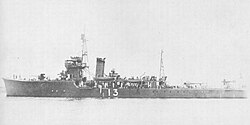W-13 class
|
Minesweeper number 13 in August 1933
|
||||||||||||||
|
||||||||||||||
|
||||||||||||||
|
||||||||||||||
|
||||||||||||||
|
||||||||||||||
The W-13 class ( Japanese 第十三 号 型 掃 海 艇 , Dai Jūsan Gō-gata Sōkaitei , dt. "No. 13 class minesweepers") was a class of six minesweepers of the Imperial Japanese Navy , which in World War II were used.
List of ships
| Surname | Shipyard | Keel laying | Launch | Commissioning | Whereabouts | |
|---|---|---|---|---|---|---|
| 1st group | ||||||
|
Dai-13-go Sōkaitei ( 第十三号掃海艇 ) minesweeper No.13 |
Fujinagata Shipyard, Osaka |
December 22, 1931 | March 30, 1933 | August 31, 1933 | sunk on January 12, 1942 by the Dutch Coastal artillery, off Tarakan ( Battle of Tarakan ) |
|
|
Dai-14-Gō Sōkaitei ( 第十四 号 掃 海 艇 ) minesweeper number 14 |
Osaka Iron Works , Osaka |
December 22, 1931 | May 20, 1933 | September 30, 1933 | sunk on January 12, 1942 by the Dutch Coastal artillery, off Tarakan (Battle of Tarakan) |
|
|
Dai-15-go Sōkaitei ( 第十五号掃海艇 ) minesweeper No.15 |
Fujinagata Shipyard, Osaka |
April 6, 1933 | February 14, 1934 | August 21, 1934 | sunk on March 5, 1945 by americans Submarine USS tilefish | |
|
Dai-16-Gō Sōkaitei ( 第十六 号 掃 海 艇 ) minesweeper number 16 |
Mitsui Zosen , Tamano |
June 20, 1933 | March 30, 1934 | September 29, 1934 | sunk on September 11, 1943 by americ. Air raid south of Makassar |
|
|
2nd group ( W-17 sub-class) |
||||||
|
Dai-17-go Sōkaitei ( 第十七号掃海艇 ) minesweeper No.17 |
Osaka Iron Works, Osaka |
January 28, 1935 | August 3, 1935 | January 15, 1936 | Decommissioned on November 20, 1945, scrapped from 1947 | |
|
Dai-18-Gō Sōkaitei ( 第十八 号 掃 海 艇 ) minesweeper number 18 |
Mitsui Zosen, Tamano |
February 2, 1935 | September 19, 1935 | April 30, 1936 | sunk on November 26, 1944 by americans Air raid southwest of Hainan Island |
|
technical description

hull
The hull of boats 13 to 16 was 74.04 meters long, 7.96 meters wide and had a draft of 2.1 meters with an operational displacement of 569 tons . The two boats No.17 and No.18 had a length of 72.27 meters, a width of 7.89 meters and a draft of 2.53 meters with a displacement of 729 tons .
drive
It was driven by two steam generators - Kampon boilers of the Yarrow type - and two geared turbine sets with which a total output of 3,200 PS (2,354 kW ) was achieved. The power was delivered to two shafts with one screw each . The top speed was 20 knots (37 km / h ).
Armament
artillery
The artillery armament consisted of two 12 cm guns with a caliber length of 45 in single mounts. These were set up in the boat center line in front of the bridge structure and behind the aft deckhouse.
Air defense
For air defense were two 13.2-mm machine guns Type 93 are available. This gun fired around 250 rounds per minute in use, the range was around 4.5 kilometers at 85 ° elevation. The 314 kilogram carriage could be rotated 360 ° and had an elevation range of −15 ° to + 85 °.
Due to the threat posed by the Allied forces during the Pacific War , the anti-aircraft armament of all remaining boats was reinforced in 1944. The armament now consisting of five 2.5-cm machine guns Type 96 , which were distributed throughout the boat.
Submarine hunting equipment
The submarine armament consisted of two type 81 depth charges in the first four boats and a type 94 launch device with 18 depth charges each, which were located on the aft deck. From 1944 the number of depth charges was increased to 36, which could now be used by two drain rails and the thrower (s).
Mine detection equipment
For mechanical rooms of sea mines ( moored mines ) possessed the class over Minenräumgeschirr consisting of two Räumottern (engl. Paravanes) which by means of davits were drained at the stern. These clearing otters were pulled to the side by the towing vehicle and held at the same height by wings. The taut towing cable could now lead the anchor ropes from the anchor mine to the clearing otter, where it was cut by cable cutters and the mine floated. It could then be detonated using handguns or ship artillery. If the anchor rope was not cut, the mine and the clearing otter would collide and explode. The towing cable could then be retrieved and any existing replacement device could be attached.
Sensors
sonar
To search for submarines one was echolocation system of the type 93 and a hydrophone -Set the Type 93 scaffolded. This hydrophone set consisted of two groups of eight sensors each, one group on each side of the boat.
See also
literature
- Harald Fock: Fleet Chronicle - The active warships involved in the two world wars and their whereabouts . Koehlers Verlagsgesellschaft, Hamburg 2000, ISBN 3-7822-0788-2 , p. 173-200 .
- Hansgeorg Jentschura, Dieter Jung, Peter Mickel: Warships of the Imperial Japanese Navy 1869-1945 . US Naval Institute Press, Annapolis 1977, ISBN 0-87021-893-X , pp. 208-209 .
Web links
- Japanese mine layers and mine hunters on ww2technik.de
- Minesweeper on combinedfleet.com (English)
- W-13 class on combinedfleet.com (English)
- W-17 class on combinedfleet.com (English)
Individual evidence
- ↑ Type 93 13.2 mm machine gun. In: navweaps.com. Retrieved June 27, 2020 (English).
- ↑ Japanese depth charges in WWII. In: navweaps.com. Retrieved July 1, 2020 .
- ↑ Japanese Sonar and Asdic (USNTMJ E-10). (PDF) US Navy Technical Mission to Japan, December 14, 1945, pp. 7 and 11 , accessed on July 1, 2020 .

